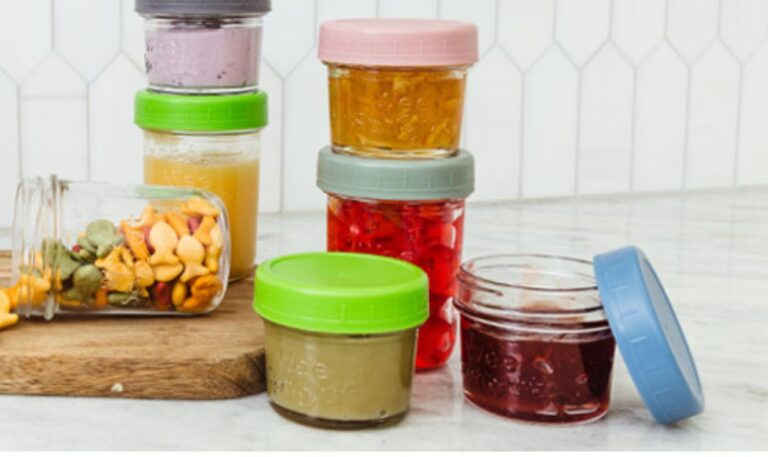Welcome to an eye-opening exploration of the potential health risks lurking within baby food containers. In this article, we delve into the concerning presence of toxic substances in some baby food containers, shedding light on the hazards they pose to the health and well-being of our little ones. By the end of this read, you will gain valuable insights into identifying and mitigating these risks, empowering you to make informed choices for the safety of your child.
Baby Food Containers: Guardians or Hazards ?
Baby food containers are essential tools in the feeding regimen of infants and toddlers, providing a means to store, transport, and serve nourishing meals. However, not all containers are created equal, and some may harbor toxic materials that can leach into the food they hold, posing a significant risk to the health of young children.
baby food containers : Common Toxic Substances :
One of the primary concerns associated with certain baby food containers is the presence of Bisphenol A (BPA), a chemical used in the production of some plastics. BPA has been linked to a range of health issues, including hormonal disruptions and developmental delays, making it a critical focus of concern for caregivers and health professionals alike.
The best our Topic : Natural skincare for pregnancy – Toxic Products and Pregnancy
Understanding the Risks :
Exposure to toxic substances from baby food containers can have far-reaching implications for a child’s health and development. From potential disruptions to endocrine function to increased risks of neurological disorders, the consequences of ingesting harmful chemicals are a cause for alarm among parents and caregivers.
Taking Action for Safer Feeding Practices :
Armed with knowledge and awareness, parents can take proactive steps to safeguard their child’s health when it comes to using baby food containers. By opting for BPA-free alternatives, choosing glass or stainless steel containers, and being vigilant about container safety and maintenance, caregivers can significantly reduce the risk of exposure to toxic substances.
Diseases Linked to Toxic Baby Food Containers
- 1. Endocrine Disruption:
Exposure to BPA from baby food containers has been linked to endocrine disruption, affecting hormone balance and potentially leading to reproductive disorders and developmental delays. - 2. Neurological Disorders:
Certain toxic substances in baby food containers have been associated with an increased risk of neurological disorders, impacting cognitive development and overall brain health in children. - 3. Respiratory Complications:
Inhalation of fumes from heated plastic containers can contribute to respiratory issues, exacerbating conditions such as asthma and allergies in young children. - 4. Immune System Suppression:
Prolonged exposure to toxins leached from baby food containers can weaken the immune system, making children more susceptible to infections and illnesses.
To ensure that you are purchasing baby food containers that are free from toxic materials and safe for your child, here are the most important steps to follow:
- 1. Check for BPA-Free Labels:
Look for baby food containers that are explicitly labeled as BPA-free. Bisphenol A (BPA) is a common chemical found in some plastics that can be harmful to health. - 2. Opt for Glass or Stainless Steel:
Consider choosing baby food containers made of glass or stainless steel as safer alternatives to plastic. These materials are generally non-toxic and do not leach harmful chemicals into food. - 3. Research Brands and Products:
Before making a purchase, research different brands and products to find out about their manufacturing processes and materials used. Look for reputable brands known for their commitment to safety.
- 4. Avoid Containers with Recycling Codes 3, 6, and 7:
Plastic containers with recycling codes 3 (polyvinyl chloride or PVC), 6 (polystyrene), and 7 (other) may contain harmful chemicals. Opt for containers with codes 1, 2, 4, or 5 instead. - 5. Inspect for Damage:
Before using a baby food container, inspect it for any signs of damage, such as cracks, scratches, or discoloration. Damaged containers are more likely to leach chemicals into food. - 6. Check for Microwave-Safe Labels:
If you plan to heat food in the container, ensure that it is labeled as microwave-safe. Using containers not designed for microwave use can lead to chemical leaching. - 7. Prioritize Reputable Retailers:
Purchase baby food containers from reputable retailers and stores that prioritize the safety of their products and adhere to strict quality standards. - 8. Look for Certifications:
Some containers may carry certifications indicating that they meet certain safety standards. Look for certifications from organizations like the FDA or ASTM. - 9. Consider Eco-Friendly Options:
Eco-friendly baby food containers made from sustainable materials are often safer and free from toxic chemicals. Look for containers that are environmentally friendly and safe for your child.
Read Also : The Connection Between Refrigerators and Food Poisoning
By following these steps and being mindful of the materials used in baby food containers, you can make informed choices to ensure that the containers you select are free from toxic materials and safe for your child’s health and well-being.

